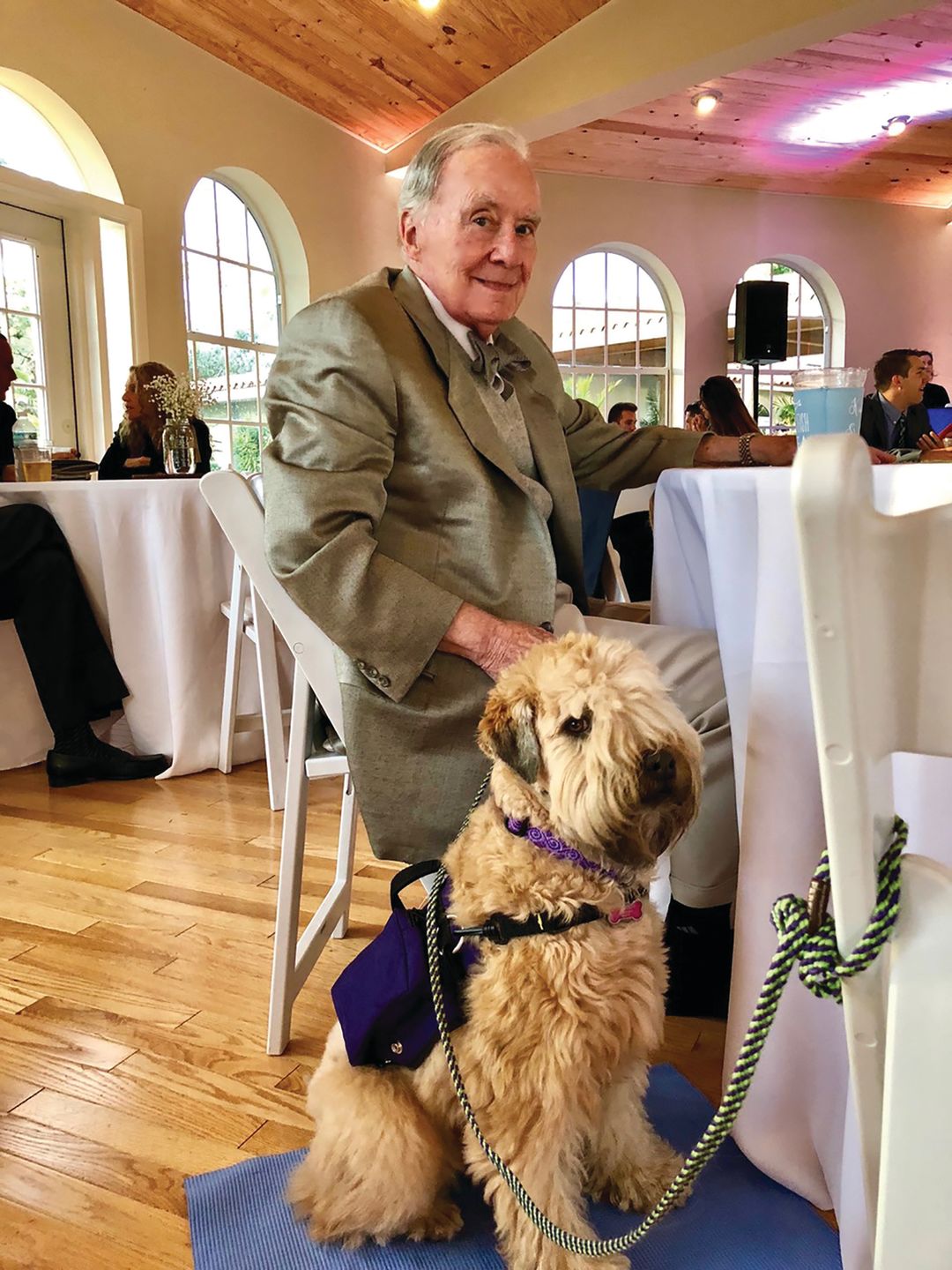Service, Support and Therapy Canines Go Everywhere—But Not Everyone is Happy

Jack Harrison and his service dog, Wyn.
Image: Courtesy Photo
When Jack Harrison suffered a broken vertebra three years ago, his wife, Bonnie, decided to enlist support from the couple’s 1-year-old Soft-coated Wheaten Terrier, Wyn. A year and 1,200 hours of training later, Wyn donned her jacket as a certified service dog.
Jack, 85, a former vice president of The New York Times who lives in The Oaks in Osprey, has regained most of his mobility. But Wyn remains a steadfast companion, picking up items Jack drops, closing low cabinets he can’t reach and even alerting Bonnie when Jack is gone too long.
“When she has on that jacket, she’s all business,” Bonnie says. “Not only has she been invaluable to Jack, Wyn supported me when I suffered a serious ankle injury.”
Support dogs are commonplace now. On leashes, in baskets, atop shopping carts, even in baby strollers, canines have gone public under loosely regulated—and even more loosely enforced—labels of guide dogs, service dogs, support dogs and therapy dogs.
It’s almost impossible to determine how many dogs have these labels because no government agency at the federal, state or local level licenses them for support or therapy. But the trend is undeniable. Four years after the Sarasota County Commission approved a “doggie dining ordinance” allowing dogs at restaurants, 70 county eateries have obtained permits. (The impact is national and goes well beyond restaurants. Delta Airlines, for example, reports that the number of support dogs—this doesn’t count “support” peacocks and hamsters—traveling on the airline exceeded 250,000 last year, an increase of 150 percent in just two years.)
“You’re seeing dogs everywhere,” says Jeanine Brawn, a dog trainer here since 1977. “You’re in Wal-Mart and there’s a dog riding in the shopping cart or sticking out of a purse. A service dog needs to be four on the floor. There are so many loopholes. You can get service jackets online or get a note from your doctor.”
Dogs that aren’t adequately trained cause problems for legitimate service dogs and their owners. An increasing number of dog issues such as fights or urination in public places have led to businesses turning the disabled and their dogs away. Brawn, whose mobility is limited by a back injury, at one time relied on a service dog, a labradoodle named Tango, whose jobs ranged from helping Brawn cross curbed streets to filling the dishwasher. When Tango was attacked by an untrained St. Bernard at a festival, he snapped back, eventually ending his career.
The Sarasota County Health Department has only received 15 complaints since its doggie dining ordinance was approved in 2014, with six of those registered last year. The most frequent complaint claims customers are letting dogs sit on their laps or on chairs, or once, drink water from a bowl at the bar.
Such incidents infuriate responsible service dog owners such as the Harrisons, whose dog Wyn had to pass a 2½-hour, 15-part test to receive its certification, including remaining stationary after a piece of steak was dropped near her feet.
“Wyn didn’t even look at it,” Bonnie says. “The exam Wyn took is so hard only 40 percent of dogs pass it. I put her certification and training records in her jacket so I can present them if anyone questions whether she is a qualified service dog.”
Dr. Mary Burch, director of the American Kennel Club’s therapy program, says more regulation is coming.
“There will be standards for emotional support dogs,” she says. “The airlines have already taken the lead. For emotional support animals, most of the larger airlines now require the dog owner provide proof the dog has completed training. In addition, the person must provide a statement from a medical professional stating that they have a diagnosis and are in treatment for a condition that results in them requiring the emotional support dog to function.”
Despite the issues she’s had, Brawn says the benefits of service dogs are far too great to turn back.
“A trained dog can sniff out a single drop of blood in a swimming pool,” Brawn says. “But they need to be trained to do their jobs. It’s not just bringing them to a store or a restaurant because you find them amusing or you want companionship.
Dog Degrees
Service dogs are trained on specific tasks to help a person with a disability and meet the Department of Justice’s Americans with Disabilities Act requirements. Examples: a guide dog for someone who is blind or deaf, or a dog trained to assist a person in a wheelchair. These dogs are permitted in any areas where the public is allowed.
Emotional support animals (ESA) are companion animals that a medical or mental health professional has determined provide a benefit for a person with a disability such as anxiety or depression. ESAs do not have the same special access privileges as service dogs.
Therapy dogs are well-trained and registered with therapy dog organizations to volunteer with their owners to help others. Examples of therapy dogs are dogs that visit schools and assisted living facilities.



